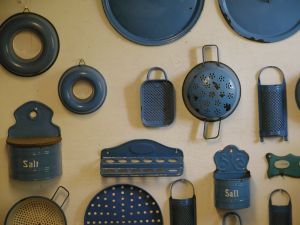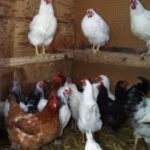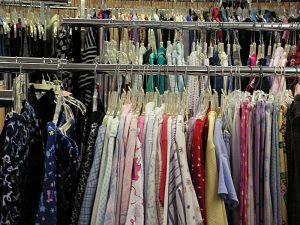I think I must have been a Depression-era housewife in a past life, because she is my ideal of someone who lives frugally, is largely self-sufficient from the kitchen garden and barnyard chickens, and is clever with what basics she has available.
Now that I live on a homestead in the mountains, I’m taking that archetype to heart and finding ways to embody it in my own frugal lifestyle. I’ve purchased vintage cookbooks from the Depression and World War II eras, I have a few laying hens, and we have a very large kitchen garden with enough to make some great home-cooked meals plus extra for canning. Over the past few months especially, I’ve been moving away from convenience foods and find myself in the kitchen more and more, baking bread and making large pots of soup that we work on for several days and share with my mother-in-law who lives next door to us on the same land.
This is how our ancestors lived, even as recently as the 1940s – how quickly we forget! For all of human existence, up until the last 60 years, we have always cooked our own food, known how to mend and sew garments, done our own basic repairs, and so on. It is only recently that these basic skills have been abandoned for the helpless state of people today, unable to cook a simple meal or sew on a missing button. I attribute this, in part, to the loss of Home Economics classes in high school and the gain of modern conveniences that do many things for us.
With this new era of incapability has come expense. If you don’t know how to cook or sew a button, you must pay someone else to do it for you. A loaf of bread in a plastic bag from the grocery store costs about $3.50 – all the ingredients to make a loaf of bread yourself costs less than 50 cents. And don’t even get me started on clothes that require dry-cleaning!
Doing for ourselves is one way to save a lot of money on the rural farmstead. When you live as far away from any stores or services as we do (12 miles to the nearest town with a post office), you learn how to fix your own sink, cook your own food and get creative with what you have on hand. Is the local hardware store closed on Sunday, but you need some heavy wire to fix a fence? That’s what wire coat hangers are for!
Another way to save lots of money is to grow your own food. During World War II there was a huge push for what were known as “Victory Gardens,” wherein lots of people planted vegetables to supplement their rationed grocery budgets and share with others so that more food could be sent to the troops fighting the war. It’s really not very hard to grow a few basic vegetables, especially if you have halfway decent soil and a source of water. Studies have shown that the biggest source of waste in the household food budget is produce that’s gone bad, and fresh produce is one of the most expensive parts of the budget too.
Cluster tomatoes on the vine are generally between $2.50 and $3.50 a pound here in California depending on the season, and that’s not organic ones. Tomatoes practically grow themselves, and there were several wild ones growing next to a building where I used to work, presumably castoff seeds from someone’s lunchtime sandwich. Corn is another easy-to-grow crop – it’s a native American grass that, as long as you plant enough for it to pollinate properly, will give you sweet corn for the table, popcorn for gift-giving or hard corn for grinding into flour depending on which variety you grow. There are many vegetable varieties that any home gardener can grow with very little effort, yet you will gain rich rewards, especially if you preserve them in jars for the winter. Contact your local Agricultural Cooperative Extension office for more information about basic gardening techniques, which varieties do best in your area, and how to preserve your harvest.
Because we’re so far away from town, you would expect that we do a lot of driving, right? Well, we used to before the price of gas doubled… now we do a lot less driving than ever before. It’s easy and cheap for a suburban-dweller to hop in the car and zip to the store for a gallon of milk (if not very energy efficient). Since it’s so time-consuming and expensive for us to do the same, I stock up when things are on sale, do without, and make things myself. Nowadays, we may go to town once a week instead of every day, especially now that my son goes to a closer school that’s only four miles away instead of 12. And when we do go, we stack up all our necessities into one trip – go grocery shopping, visit the library, drop off some homespun yarn at the consignment shop and mail some packages at the post office.
The most difficult thing about all of this is changing the way you think. If you have lived on a farm or homestead all your life, this won’t take much at all. If you’re a city slicker who has moved out to live “the good life,” you’ll need to do a whole lot of thinkin’ about how you do things on a daily basis to work towards a frugal lifestyle.
Food: Cook it yourself, grow it yourself, preserve it yourself. And here’s an extra frugal tip – some foods come in re-useable containers, like canning jars, fabric sacks (just like grandma used on her 1930s quilts) and drinking glasses.
Shelter: We live in a 1960s mobile home that we got for free (a trailer park owner wanted to get rid of it quickly), we heat exclusively with wood, and we have a swamp cooler for the hot months. McMansions may make you feel like royalty, but the price in overextended mortgage credit and heating/cooling expenses becomes the price of not seeing your family much, daycare costs, and having almost no free time for doing your own money-saving tasks like repairs, gardening or cooking. It’s a stress-filled, counterproductive treadmill.
Clothing: The vast majority of our family’s clothing is from thrift stores and yard sales. A few things I buy new, like undergarments (the reasoning behind this should be obvious), shoes and work pants, because these last two need to survive as long as possible. I try to buy the most well-made shoes and pants that I can afford so that they last and can be repaired or patched for longer wear.
Entertainment: When we can afford it, we go to cheaper matinee movies instead of evening shows, rent DVDs, and get used video games for half what new ones cost. For the kids, there are many good internet websites where they can play games and look at fun things for free. We also enjoy playing board games, cards and dice games, and we also do outside activities together like berry picking in summer or sledding in winter. Often, after our son has gone to bed, my husband will read aloud to me while I do some needlework or spin yarn.
Hobbies: If you’re looking for a hobby, take up something that will be useful to the household. Collecting things may be fun, but does all that stuff contribute anything other than more clutter? Sewing, fiber arts, woodworking, welding, gardening, car repair, beekeeping, gourmet cooking... all these activities are fun hobbies, yet they all contribute directly to a successful frugal household, and in some cases can bring in extra income or be used to barter with your neighbors.
Doing things for yourself not only saves you a lot of money, it helps you feel much more capable and is really fulfilling. Instead of wasting time watching other people do things on TV, turn the box off and do them yourself. It’s really not all that hard, especially if you’re a little bit patient. I always tell myself, “If that person can do it, then so can I.” Well, within limits of course – I’m not going to be an Olympic athlete any time soon, but I can make a quilt, build a shed, raise chickens, split firewood, milk a goat, cut my son’s hair, needlepoint a pillow, grow and preserve food, go from sheep to crocheted shawl and cook a delicious and inexpensive meal for my family. I can even sew on that missing button, assuming the kitten doesn’t bat it under the bed so I can’t find it.







